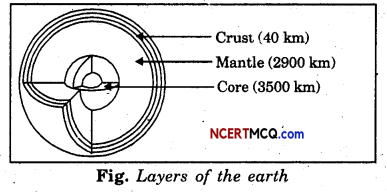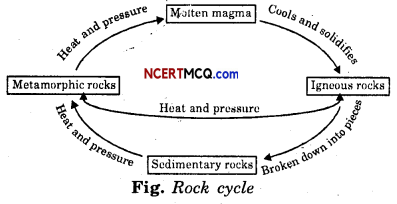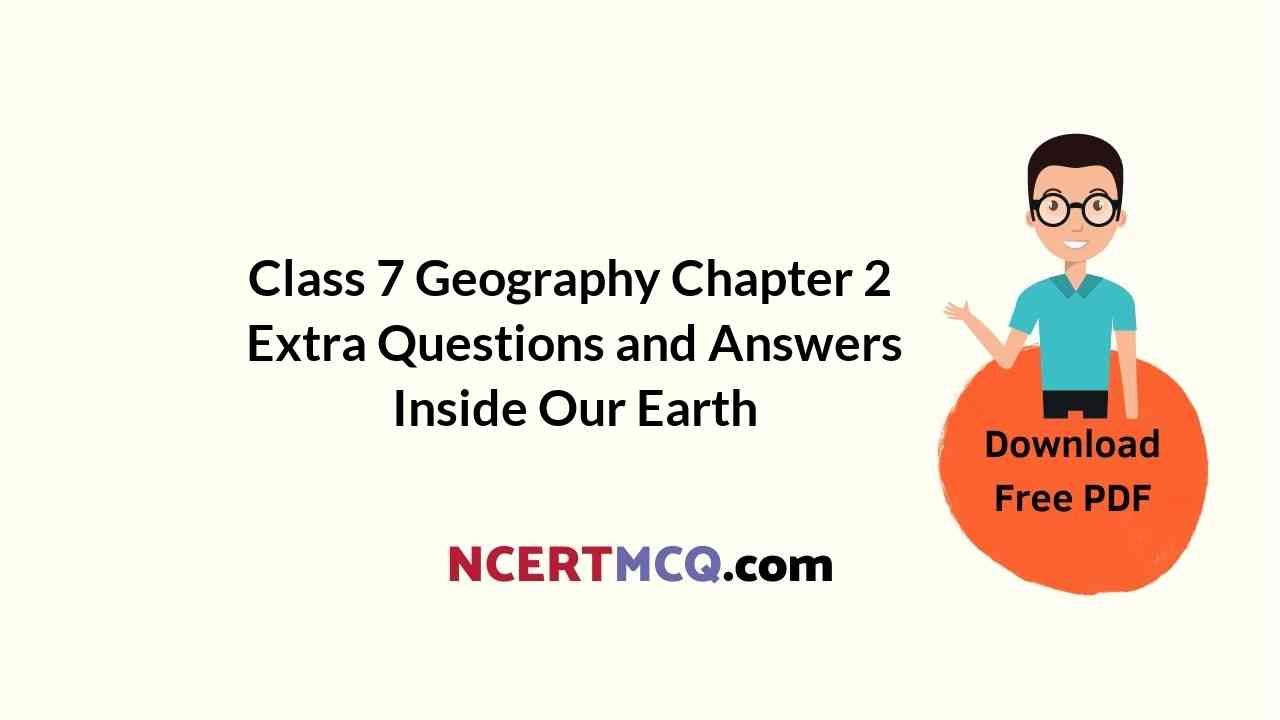Check the below NCERT MCQ Questions for Class 7 Geography Chapter 2 Extra Questions and Answers Inside Our Earth with Answers Pdf free download. https://ncertmcq.com/extra-questions-for-class-7-social-science/
Inside Our Earth Class 7 Extra Questions Geography Chapter 2
Class 7 Geography Chapter 2 Extra Questions And Answers Question 1.
What is the earth made up of?
Answer:
The earth is made up of a number of concentric (having a common centre) layers, one inside another.
Class 7 Geography Chapter 2 Extra Questions Question 2.
What are the three layers of the earth?
Answer:
The three layers of the earth are – crust, mantle and core.
Ncert Solutions For Class 7 Geography Chapter 2 Extra Questions Question 3.
What do you mean by ‘sial’?
Answer:
The continental mass of the crust mainly contains silica and alumina. It is therefore that this part of the crust is also called sial (si = silica, al = alumina).
Inside Our Earth Class 7 Extra Questions And Answers Question 4.
What is meant by ‘sima’?
Answer:
The oceanic crust has mainly two minerals – silica and magnesium. It is therefore that this part of the crust is called sima (si = silica, ma = magnesium).
![]()
Ncert Class 7 Geography Chapter 2 Extra Questions Question 5.
Draw a labelled diagram to show different layers of the earth.
Answer:

Inside Our Earth Class 7 Extra Questions Question 6.
What do you know about the middle layer of the earth?
Answer:
It is called mantle. It is just beneath the crust and extends up to a depth of 2900 km below the crust.
Chapter 2 Geography Class 7 Extra Questions Question 7.
What is crust? Give its features.
Answer:
- The uppermost layer of the earth’s surface is called the crust.
- Following are its features :
- It is the thinnest of all the earth’s layers.
- It is about 40 km (35 km on continental mass and 5 km on the ocean floors) thick.
- Major minerals found in this layer are silica, alumina and magnesium.
Class 7 Geography Ch 2 Extra Questions Question 8.
Which is the innermost layer of the earth? Give its features.
Answer:
- The innermost layer of the earth is called core.
- Following are its main features –
- It extends upto 3500 km beneath mantle.
- It is mainly made up of nickel and iron (ferrous). Therefore, it is also called nife.
- Its central part bears extremely high temperature and pressure.
Geography Chapter 2 Class 7 Extra Questions Question 9.
What is rock?
Answer:
Any natural mass of mineral matter that makes up the earth’s crust is called a rock.
![]()
Extra Questions For Class 7 Geography Chapter 2 Question 10.
What are the types of rock? Name them.
Answer:
Rocks are mainly of three types. These are :
- Igneous rock,
- Sedimentary rock,
- Metamorphic rock.
Geography Class 7 Chapter 2 Extra Questions Question 11.
What do you mean by rock cycle?
Answer:
Transformation of one type of rocks into another type under certain conditions in a cyclic manner is called rock cycle.
Class 7 Ncert Geography Chapter 2 Extra Questions And Answers Question 12.
What are rocks made up of?
Answer:
Rocks are made up of different minerals.
Class 7 Geography Chapter 2 Worksheet With Answers Question 13.
What are minerals?
Answer:
Minerals are naturally occurring substances which have certain physical properties and a definite chemical composition.
Class 7 Geography Chapter 2 Short Questions And Answers Question 14.
What is lava?
Answer:
Lava is a fiery red molten mass of magma which comes out of the interior of the earth to its surface during a volcanic eruption.
![]()
Class 7 Chapter 2 Geography Extra Questions Question 15.
How are extrusive igneous rocks formed? Discuss.
Answer:
When molten lava comes to the earth’s surface, it rapidly cools down and solidifies. This gives rise to very fine-grained igneous rocks. The rocks formed in such a way are called extrusive igneous rocks.
Question 16.
How are intrusive igneous rocks formed? Discuss.
Answer:
Sometimes molten magma cools down deep inside the earth’s crust and does not come above the surface. This gives rise to large-grained igneous rocks. The rocks formed in such a way are called intrusive igneous rock.
Question 17.
Give one example each of extrusive and intrusive igneous rocks.
Answer:
Extrusive igneous rock – basalt.
Intrusive igneous rock – granite.
Question 18.
Name one place where you will find basaltic rocks.
Answer:
Deccan plateau.
Question 19.
Name the rock of which the grinding stone used to prepare paste or powder of spices is made up.
Answer:
Granite.
Question 20.
What are sedimentary rocks? Give an example.
Answer:
- When loose sediments are compressed and hardened, they form layers of rocks. These rocks are called sedimentary rocks.
- Sandstone is an example of sedimentary rock.
Question 21.
Name two agents which help in transport and deposition of sediments.
Answer:
Wind and water.
Question 22.
Give one special feature of sedimentary rock.
Answer:
These rocks contain fossils of plants, animals and micro-organisms that once lived on them.
![]()
Question 23.
How are metamorphic rocks formed? Give examples.
Answer:
- Under great heat and pressure, igneous and sedimentary rocks change to form metamorphic rocks.
- Slate (from clay) and marble (from limestone) are examples of metamorphic rocks.
Question 24.
Mention two uses of rocks.
Answer:
Following are two uses of rocks –
- Hard rocks are used in making houses, roads, statues and buildings, etc.
- These are also used in daily life for various purposes, e.g., for grinding stones, etc.
Question 25.
What are primary or igneous rocks? What are its types?
Answer:
- The rocks formed by the cooling and solidification of molten magma are called primary or igneous rocks.
- They are of the following two types :
- Intrusive igneous rocks,
- Extrusive igneous rocks.
Question 26.
Explain rock cycle with the help of a suitable diagram.
Answer:

Question 27.
How are minerals useful to humankind? Or Give some uses of minerals.
Answer:
Minerals are useful in the following ways :
- Some of them are used as fuels, e.g., coal, petroleum, natural gas, etc.
- Some are used in industries, e.g., iron, aluminium, gold.
- Some are used in medicines, e.g., minerals of sodium, iron, calcium, chlorine, etc.
- Some are used in making fertilizers, e.g., minerals of nitrogen, potassium, phosphorus, etc.,
Multiple Choice Questions (MCQs)
1. Which one of the following is different from the other three layers, with reference to the interior of the earth?
(a) Crust
(b) Mantle
(c) Exosphere
(d) Core
Answer:
(c) Exosphere.
2. Why is the earth crust called Sial?
(a) Because it consists of silica and alumina.
(b) Because it consists of silicon and aluminium.
(c) Because its constituents are silica and magnesium.
(d) Because it consists of nickel and ferrous.
Answer:
(a) Because it consists of silica and alumina.
![]()
3. Which one of the following minerals are found in the oceanic crust?
(а) Silica and aluminium
(b) Silica and magnesium
(c) Nickel and silica
(d) Ferrous and nickel.
Answer:
(b) Silica and magnesium.
4. At which one of the following places the deepest mine of the world is situated?
(a) North America
(b) South America
(c) Europe
(d) South Africa.
Answer:
(d) South Africa.
5. Which one of the following is the innermost layer of the earth?
(a) Crust
(b) Nife (core)
(c) Mantle
(d) Troposphere.
Answer:
(b) Nife (core).
6. What is the radius of the earth?
(a) 6371 km
(b) 6271 km
(c) 7000 km
(d) 7100 km
Answer:
(a) 6371 km.
7. Which one of the following terms is used for any natural mass of minerals that make up the earth’s crust?
(a) Sediments
(b) Oceanic crust
(c) Rock
(d) Core
Answer:
(c) Rock.
![]()
8. Which one of the following is different from the other three, with reference to the types of rocks?
(a) Igneous rock
(b) Sedimentary rock
(c) Metamorphic rock
(d) Interior rock.
Answer:
(d) Interior rock.
9. Which of the following rocks is also called the primary rocks?
(a) Metamorphic rock
(b) Igneous rock
(c) Sedimentary rock
(d) Crust.
Answer:
(b) Igneous rock.
10. Which of the following statements is false about the intrusive igneous rocks?
(а) They are found on the earth crust.
(b) They have large-grained structure.
(c) They are formed beneath the earth crust
(d) Granite is an example of intrusive igneous rocks.
Answer:
(а) They are found on the earth crust.
11. Which one of the following rocks is formed when the molten lava cools down on the earth’s surface?
(a) Sedimentary rock
(b) Metamorphic rock
(c) Extrusive Igneous rock
(d) Rock cycle.
Answer:
(c) Extrusive Igneous rock.
12. Deccan plateau is made up of which one of the following rocks?
(a) Granite
(b) Cobalt
(c) Intrusive igneous rock
(d) Basalt.
Answer:
(d) Basalt.
13. Which one of the following rocks is formed by the compressed and hardened sediments?
(a) Metamorphic rock
(b) Sedimentary rock
(c) Intrusive igneous rock
(d) Extrusive igneous rock.
Answer:
(b) Sedimentary rock.
14. Which one of the following is a sedimentary rock?
(a) Marble
(b) Granite
(c) Sandstone
(d) Basalt.
Answer:
(c) Sandstone.
15. Which one of the following rocks contain fossils of plants, animals and other micro-organisms?
(a) Sedimentary rocks
(b) Metamorphic rocks
(c) Igneous rocks
(d) Intrusive igneous rocks.
Answer:
(d) Intrusive igneous rocks.
![]()
16. Igneous and sedimentary rocks are changed into;
(a) Basalt rocks
(b) Metamorphic rocks
(c) Intrusive igneous rocks
(d) Extrusive igneous rocks
Answer:
(b) Metamorphic rocks.
17. Which one of the following reasons is responsible for metamorphic rocks formation?
(a) Heat and pressure
(b) Heavy rainfall
(c) High atmospheric pressure
(d) Fertile soil.
Answer:
(a) Heat and pressure.
18. Which one of ‘the following metamorphic rocks is formed by the limestone?
(a) Sandstone
(b) Slate
(c) Marble
(d) Basalt.
Answer:
(c) Marble.
19. Which one of the following is the thinnest layer of the earth?
(a) Core
(b) Crust
(c) Mantle
(d) Deepest mine.
Answer:
(b) Crust.
20. Which one of the following terms is used for the process of transformation of the rock from one form to another?
(a) Water cycle
(b) Condensation
(c) Photosynthesis
(d) Rock cycle
Answer:
(d) Rock cycle.
